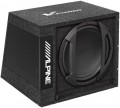Type
—
Active. Subwoofer equipped with its own built-in amplifier. Such a subwoofer can be connected directly to the signal source, without any additional amplifiers; while the built-in amplifier, by definition, has characteristics that best match the parameters of the speaker. And when using other amplifiers, an active subwoofer reduces the load on them, which has a positive effect on sound quality and power. In addition, your own amplifier can be equipped with its own sound tuning tools and other additional features. On the other hand, all this affects the cost of the device, and active models are somewhat more difficult to install, because. require separate power supply.
—
Passive. Subwoofers not equipped with their own amplifier. They are cheaper than active ones and easier to install. work without a separate power supply, however, the connection is fraught with some difficulties: for normal operation, an amplifier is needed, the characteristics of which (in particular power and impedance, see below) must optimally match the parameters of the subwoofer.
Number of woofers
The number of main speakers installed in the subwoofer. Most models are equipped with a single speaker, which is considered sufficient for quite decent bass reproduction.
Models with two speakers sound louder and have better sensitivity, but are complex in design (as a result, more expensive) and more difficult to install, and therefore are relatively rare.
Rated power
The average (root mean square — RMS) power of the input signal, at which the subwoofer is able to work continuously without negative consequences (damage, failure) for at least an hour. The rated power of the subwoofer must be greater than the power of the amplifier connected to it — in order to avoid overloads.
Max. power
The maximum signal power that the subwoofer is able to withstand for a short time (up to several seconds) without any negative consequences. When selecting an amplifier-subwoofer pair, it is recommended to take a subwoofer with a maximum power of at least twice the maximum power of the amplifier. In general, the higher the maximum power, the more resistant the subwoofer is to overloads.
Frequency range
The range of audio frequencies reproduced by the subwoofer. It is believed that the human ear is capable of perceiving a frequency range of the order of 16 – 20,000 Hz, but in this case note that the subwoofer is designed to reproduce the lower frequency band (up to 200 Hz). Accordingly, in the case of the lower limit of the range, everything is simple: “the lower, the better”; the upper one should not be lower than the lower limit of the main car audio — otherwise there will be "gaps" in the frequencies, which will affect the sound quality.
Sensitivity
Sensitivity determines the loudness of the subwoofer when a signal of a certain power is connected to it: with equal signal power and impedance (see below), the subwoofer with the higher sensitivity will sound louder.
Bass level control
Since the subwoofer was originally designed to reproduce bass, in fact, in this case, it implies the presence
of its own volume control, which allows you to change it without affecting the signal source. This allows you to easily set the desired bass level relative to the rest of the sound of the audio system (for different cases, this ratio may be different).
Phase control
The ability
to change the phase of the sound coming from the subwoofer, in other words, the ability to adjust the sound from the subwoofer to lead or lag relative to the main speakers. This need may be due to the fact that the sound from the main speakers and from the subwoofer can reach the listener with different delays — due to the location of the speakers and the features of the electronics — which negatively affects the sound quality. Adjusting the phases allows you to harmonize this sound. This feature is usually found in active subwoofers.
High voltage input
The presence of a
high-voltage input at the active (see "Type") subwoofer. Such an input greatly expands the possibilities for connection. Usually active subwoofers are connected via a linear (low-voltage) input directly to the radio. The high-voltage input allows you to connect the speaker to a separate power amplifier, like a passive subwoofer.

